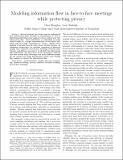Modeling Information Flow in Face-to-Face Meetings while Protecting Privacy
| dc.contributor.author | Rudolph, Larry | |
| dc.contributor.author | Zhenghao, Chen | |
| dc.date.accessioned | 2005-12-14T19:42:37Z | |
| dc.date.available | 2005-12-14T19:42:37Z | |
| dc.date.issued | 2006-01 | |
| dc.identifier.uri | http://hdl.handle.net/1721.1/30288 | |
| dc.description.abstract | Social networks have been used to understand how information flows through an organization as well as identifying individuals that appear to have control over this information flow. Such individuals are identified as being central nodes in a graph representation of the social network and have high "betweenness" values. Rather than looking at graphs derived from email, on-line forums, or telephone connections, we consider sequences of bipartite graphs that represent face-to-face meetings between individuals, and define a new metric to identify the information elite individuals. We show that, in our simulations, individuals that attend many meetings with many different people do not always have high betweenness values, even though they seem to be the ones that control the information flow. | en |
| dc.description.sponsorship | Singapore-MIT Alliance (SMA) | en |
| dc.format.extent | 2219317 bytes | |
| dc.format.mimetype | application/pdf | |
| dc.language.iso | en | en |
| dc.relation.ispartofseries | Computer Science (CS) | en |
| dc.subject | social networks | en |
| dc.subject | universal hashing | en |
| dc.subject | privacy | en |
| dc.subject | information flow | en |
| dc.subject | pervasive computing | en |
| dc.subject | face-to-face meetings | en |
| dc.subject | models | en |
| dc.subject | location tracking | en |
| dc.title | Modeling Information Flow in Face-to-Face Meetings while Protecting Privacy | en |
| dc.type | Article | en |
